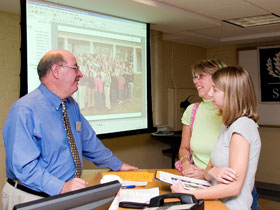  |
| HOME | THIS ISSUE | CALENDAR | PATENTS | BACK ISSUES | < BACK | NEXT > |
Internet plays growing role in recruiting prospective studentsby Elizabeth Omara-Otunnu - October 3, 2005 |
||||
|
Prospective students and their families visiting campus for the fall admissions open house this year had a new tool to help them plan their day. When they registered online to attend, they filled out an electronic form about the topics that interested them, and immediately received an automated schedule, with information sessions, presentations, and tours prioritized – academics first – to help them get through everything in the day. The use of technology in recruitment is growing rapidly. Many prospective students now make their first contact with the University through the Internet, and the Division of Enrollment Management has embarked on a broad effort to infuse the latest technology into the entire process. “Students are information-savvy, and their expectations of technology are at an all-time high,” says M. Dolan Evanovich, vice provost for enrollment management. “They want to be at a university that’s high-tech.”
High-tech expectations The process is being driven by student demand. “A gradual but fundamental change is occurring among students. We see it in the data,” says John Barry, director of university communications, who is part of a team that has conducted a survey of applicants to the University for the past six years. “Prospective students want access to specific information online, when they want it.” Before students apply, for example, they want to know about entrance requirements, majors, what it’s like to live on campus, and what it will cost. After they’ve been admitted, they want to make arrangements for orientation, register for classes, and identify where they’re going to live. “They’re doing all this electronically,” Evanovich says. This year, for the first time, students wanting to check out the University of Connecticut were able to take a virtual tour before setting foot on any of its campuses, a feature that’s expected to be of interest to a large proportion of prospective applicants, particularly those living out of state. “Until now, most of our out-of-state students have been from New England or the Northeast, but now we’re recruiting students from North Carolina, Texas, Florida, Illinois, and California,” says Lee H. Melvin, director of undergraduate admissions. “Their parents may not be able to bring them here for a campus visit, so a virtual tour can be very helpful early in the selection process.” Another feature on the admissions website enables students to identify possible majors based on their interests or career aspirations.
Applying online The use of technology by applicants is increasing. In 2004, the University received 19,574 applications, of which 5,410 were online; in 2005, 19,763 applications were received, 9,556 of them electronically – a 77 percent increase in one year.
Melvin says online processes enable admissions officers to review applications more quickly and respond to students sooner. Test scores are already received electronically, and staff hope soon to receive high school transcripts online. The admissions office is also planning an online drop box for students’ essays and letters of recommendation. Although most Connecticut students now have access to a computer at home or at school, for those who may not, the University has also introduced “electronic application days.” Beginning this fall, admissions officers will visit schools in urban and rural areas to help applicants fill out their forms electronically. “We want to make sure we don’t disenfranchise low-income students by transitioning to electronic applications,” says Melvin.
Personal touch “Picking up the phone and speaking with a student, getting their reaction to the news that they’ve won a scholarship, for example – you can’t get that online.” Future plans focus on developing greater two-way communication with prospective students and their families, both to help the University recruit well-qualified students and to help families choose UConn. “We’re moving away from traditional, one-way, print-based communication – which has been very successful over the past few years – to relationship-based, integrated data-driven communications,” says Evanovich. An RFP to purchase web-based software for this purpose was issued recently. It is expected that the software will store information entered online by students from their first contact with the University through graduation and maybe beyond. A profile of each student will be compiled and information sent to them as needed. “We want to build a personal relationship with the students,” Evanovich says. “The more data we have about each student, the better we are able to tailor our communications to their needs and requests.” He says the approach is used by some online retailers, who retain information about the sizes, colors, and styles customers favor, and adapt their marketing accordingly. In addition to helping students make decisions, the data can be analyzed by the University for planning academic offerings and other services. |
| ADVANCE HOME UCONN HOME |

